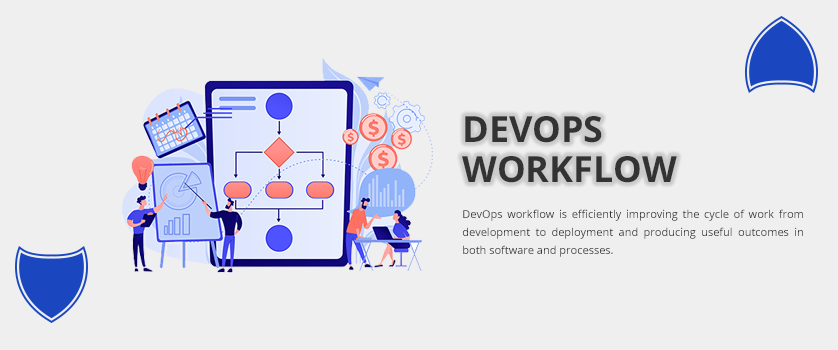
DevOps Workflow
The advent of new technologies has fundamentally transformed
software development workflows and processes in the last
decade, which has further changed how consumers consume
services daily. Today, organizations are working hard to keep
up with these consumption practices and avoid obsolescence,
which has resulted in the swift adoption of DevOps, the tech
responsible for agile and scalable software development and
delivery.
Powered by automation and an agile, collaborative workflow,
DevOps enables organizations to deliver enterprise-grade
software products with speed, reliability, personalized
features, etc., while simultaneously ensuring compliance with
customer demand and expectations. It is, hence, leveraging
this workflow that organizations worldwide are currently
accelerating software development and delivery.
So, let us take a thorough look at the DevOps Workflow and
understand how it is helping organizations achieve agile
development.
DevOps Workflow:
In this day and age of rapid release and delivery, DevOps
workflow is efficiently improving the cycle of work from
development to deployment and producing useful outcomes in
both software and processes. Moreover, it allows teams to
safely and rapidly deploy changes to applications and
infrastructure. Designed to reduce friction, automate tasks,
enable rapid iteration, and reinforce best practices like
security, efficiency, and auditability, etc., DevOps Workflow
is the key to developing and delivering quality software at a
higher velocity.
Other characteristics that define the DevOps Workflow are:
-
Increased collaboration and communication among teams.
-
Use of effective tools for rapid and reliable deployment
and innovation
- Provides speed, scale, and consistency.
-
Helps manage complex environments at scale.
-
Mirrors ideal process in the configuration jobs.
-
Ensures the latest code is always in a deployable mode and
production-ready.
Essential Elements of DevOps Workflow:
DevOps workflows generally vary from one organization/project
to another. However, certain elements are essential to all
workflows. These ensure reduced risk of miscommunication or
misalignment among team members and agile software development
and continuous delivery.
These essential elements are:
-
Planning: Involves assigning user stories, tasks, defects, etc. to
product owners and developers and planning the next
iteration of software development. Here, the team identifies
the schedule planning and task tracking tools that are
needed to achieve a seamless and efficient project
management cycle and ensure timely product delivery.
-
Development:
Once the tasks are assigned, the developers start working on
the development. During this time, the source code is
version controlled and stored in Git, along with the changes
committed by the developers. Finally, the code is shared
among the developers using GitHub, as it ensures privacy and
security of the code as well as seamless
collaboration.
-
Continuous Integration: Continuous integration involves the integration of multiple
pipelines and the preparation of the main and customized
build. The team configures and automates the environment
setup and auto triggers alerts and reports. This helps
minimize risks when various new changes are implemented on
the main build. Here, tools like Jenkins are used to pull
the code and the build is done, during scheduled check-in,
using tools like Maven or ANT.
-
Continuous Testing: This phase of the workflow encompasses virtualizations and
simulation. Moreover, the team develops and triggers the
test script automation, with simulation and physical devices
and performs unit testing, code analysis, and more. To
minimize the time and effort devoted to testing without
compromising the quality of the code and user experience,
tools like Jenkins, CircleCI, JUnit, SonarQube, and GitLab
CI are used by the team.
-
Continuous Delivery: After continuous testing, continuous delivery is executed
on different environments based on approvals through various
tools like IBM UrbanCode Deploy. Furthermore, the team
deploys the build on devices and sensors, rollbacks
management on live environment, generate automated alerts
and reports on failed scenarios and issues. This phase also
involves functional and acceptance testing in suitable test
environments using various automated testing tools like
Selenium.
-
Continuous Monitoring: Finally, after software deployment, the team monitors and
troubleshoots the production and test environment to ensure
stable performance and functionality for increased customer
satisfaction. This is an ongoing activity that also involves
performance analysis and logging, raising automated alerts
on various issues, gathering customer feedback, validating
device health, among other things. These tasks are automated
with the help of tools like Prometheus, Datadog, Pingdom,
New Relic, Grafana, Elastic (ELK) Stack, Splunk, etc
Conclusion:
DevOps and its workflow have had a tremendous impact on the
current IT infrastructure and software process, which has
enabled organizations to integrate innovation, agility, and
value into their software products. Hence, a carefully managed
DevOps workflow and the culture of learning within an
organization can ensure quick identification and rectification
of issues, monitoring, prediction of failure, environment
management, and delivery and execution of reliable software as
soon as possible.


